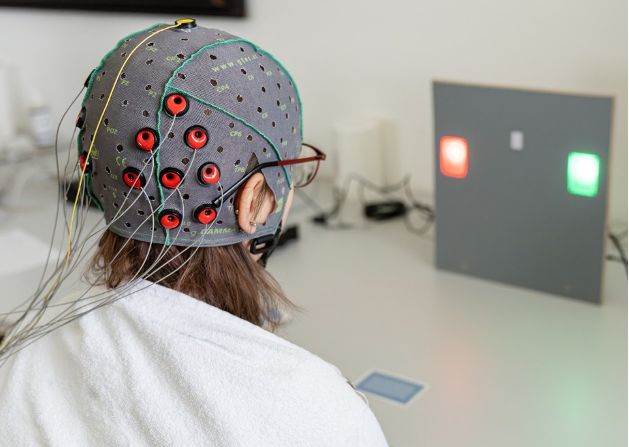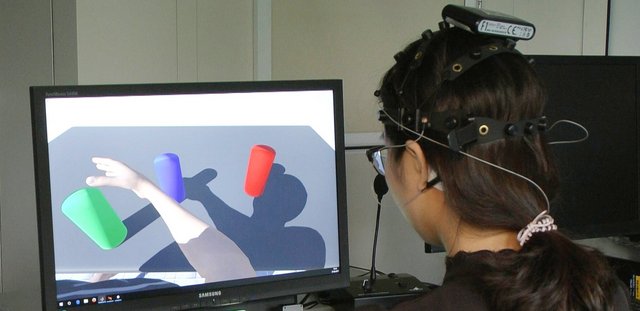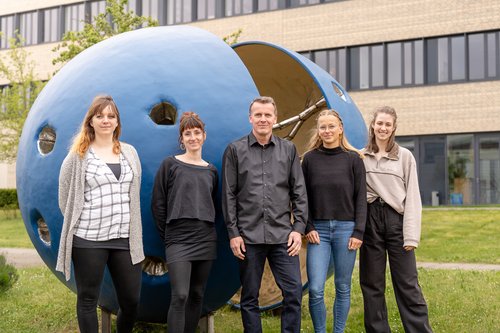AG Brain-Machine Interface
The Brain-Machine Interface (BMI) work group focuses on neurophysiological approaches to decode actions from human brain activity (in particular as reflected in the electroencephalogram (EEG)). Our main focus is on the decoding of attention, which enables communication by means of cognitive processes through conscious response to a target stimulus, e.g., the illumination of a pushbutton.
Patients after stroke or paraplegia often suffer from motor or sensory dysfunction. The goal of the BMI projects is to support these patients in regaining lost motor or sensory function by means of brain-controlled devices.
Besides the EEG our research includes experiments based on brain magnetic fields (magnetoencephalogram (MEG) and functional magnetic resonance imaging (fMRI)). The analysis of these signals is widely based on machine learning approaches.
- Head
Head

Since its foundation, the working group has been headed by Prof. Dr.-Ing. Hermann Hinrichs, who retired in February 2023. Since March 2023, the AG is headed by Dr. Christoph Reichert.
Christoph Reichert studied computer science at the Otto von Guericke University Magdeburg from 2001 to 2007. Afterwards, he worked as a research assistant at the University Clinic for Neurology in Magdeburg. He has been employed at LIN since 2015. He completed his PhD in 2016 at the Faculty of Computer Science at Otto-von-Guericke University.
His work at the LIN was accompanied by a close cooperation with the STIMULATE research campus, where he led the Brain-Machine Interfaces research group from 2018 to 2019. Since 2022, he is one of the postdoc representatives at LIN. His main interest is in the application of machine learning for decoding electrophysiological brain signals.
- Members
Members
Head Dr. Christoph Reichert +49-391-6263-92531 christoph.reichert@lin-magdeburg.de Secretary Carola Schulze +49-391-6263- 92311 carola.schulze@lin-magdeburg.de PhD student Lisa Klemm lisa.klemm@lin-magdeburg.de Technical staff member Steffi Bachmann Students Julie Morgan Alumni Franziska Tittel (Msc) Ardiansyah Esmondo (Msc) Fabian Igor Tellez Ceja (Msc) Amr Farahat (Msc) Bernadette Schneider (Dr.-med.) David Weizel (Msc) - Projects
Projects

Volunteer test person in front of the experimental setup of a brain-computer interface. Visual spatial attention as a control signal
In this project we develop novel paradigms that permit to generate control signals, simply by directing attention to peripherally presented symbols (N2pc paradigm), independent of eye movemements. To achieve this, we decode the electroencephalogram using an efficient dedicated algorithm. In the long run, we intend to probe this procedure to provide an instrument of communication for severely paralyzed patients.
Unidirectional Communication using a hyperscanning brain-computer interface
Hyperscanning is a technique used to measure the brain activity of more than one person at the same time. So far, this technique has been used to test collaborative BCIs in which the participants pursue the same goal at the same time, i.e. to generate a command by means of brain activation. In this project, we want to extend this idea and use the synchrony or asynchrony of two simultaneously measured electroencephalograms to transfer information from one person to another. The aim is to show that covert communication, i.e., not perceivable by a third person, is possible and to develop methods for other neuroscience areas where hyperscanning is used, e.g. in the study of synchronization of brain activity during social interaction.
Completed Projects
Diagnostic Glove: Disease Diagnoses in daily life from wearable kinematics
A cooperation with the University Hospital’s Department of Neurology and the IKND
The aim of this project was to use data gloves (gloves or exoskeletons equipped with sensors) to detect specific motor diseases in early stages. Some motor diseases can subjectively not be differentiated in early stages but their prognoses are differently severe. Using sensor data in combination with machine learning techniques, we identified typical patterns associated with natural hand movements at different ages. The dynamically variable nature of individual movements was particularly challenging for decoding. Finally, we examined hand movement data from ALS patients and a control group to characterize typical patterns of impairment specific to this disease.
Brain-Machine Interface – OP planning and selection procedures (as subproject of the research campus STIMULATE)
The project is concerned with the investigation of paradigms and algorithms that make it possible to identify brain function for robust BMI control in different forms of brain lesion after stroke. On the one hand, this includes the individual optimal localization of non-invasive or invasive electrodes (grids) and, on the other hand, enables the detection of intended actions in the single triangle, i.e. in real-time, and the generation of machine commands. Therefore, in this work package, selection procedures are to be developed which allow a simple intuitive control of an autonomously acting robot arm.
In-Ear-BMI (as subproject of the research campus STIMULATE)
This project comprises the development and implementation of hardware and software components for a miniaturized system for the acquisition of EEG signals from the auditory canal, realized as a smartphone extension. Research goals include the development of suitable electrodes and electrode localizations, dedicated miniaturized amplifiers/signal converters and smartphone-based analysis software that can extract specific brain function parameters from the EEG based on neuroscientific approaches.
- Open Science
Open Science
The BMI Group supports Open Science. We mainly publish Open Access and make our research data available in repositories.
Data sets
Reintsema, L. H., Reichert, C. 2024. Hyperscanning brain-computer interface based on synchronous and asynchronous interindividual SSVEP signals. Zenodo, DOI: 10.5281/zenodo.10809098, zenodo.org/doi/10.5281/zenodo.10809098
Reichert, C., Dürschmid, S., Sweeney-Reed, C.M., Hinrichs, H. 2023. EEG recordings comprising evoked potentials related to attention to colored laminar stimuli. Zenodo, DOI: 10.5281/zenodo.8188856, zenodo.org/doi/10.5281/zenodo.8188856
Reichert, C., Klemm, L., Kalyani, A., Schreiber, S., Kühn, E. & Azanon, E. 2022. Finger kinematics of natural hand movements recorded by an exoskeleton data glove in younger and elderly persons. Universitätsbibliothek, DOI: 10.24352/UB.OVGU-2022-080, open-science.ub.ovgu.de/xmlui/handle/684882692/105
Reichert, C., Tellez Ceja, I. F. & Dürschmid, S. 2022. Spatial attention shifts to colored items - an EEG-based brain-computer interface. Otto von Guericke University Library, Magdeburg, Germany, 19.11.2020, DOI: 10.24352/UB.OVGU-2020-155
- Selected Publications
Selected Publications
Reichert C, Sweeney-Reed CM, Hinrichs H and Dürschmid S (2024) A toolbox for decoding BCI commands based on event-related potentials. Front. Hum. Neurosci. 18:1358809. https://doi.org/10.3389/fnhum.2024.1358809
Krueger J, Krauth R, Reichert C, Perdikis S, Vogt S, Huchtemann T, Dürschmid S, Sickert A, Lamprecht J, Huremovic A, et al. 2022. Functional electrical stimulation driven by a brain–computer interface in acute and subacute stroke patients impacts beta power and long-range temporal correlation. In 2022 IEEE Workshop on Complexity in Engineering (COMPENG). IEEE. https://doi.org/10.1109/COMPENG50184.2022.9905448
Reichert C, Dürschmid S, Sweeney-Reed CM, Hinrichs H. 2022. Visual spatial attention shifts decoded from the electroencephalogram enable sending of binary messages. In 2022 IEEE Workshop on Complexity in Engineering (COMPENG). IEEE. https://doi.org/10.1109/COMPENG50184.2022.9905445
Reichert C, Klemm L, Mushunuri RV, Kalyani A, Schreiber S, Kuehn E, Azañón E. 2022. Discriminating Free Hand Movements Using Support Vector Machine and Recurrent Neural Network Algorithms. Sensors. 22(16):1-12. https://doi.org/10.3390/s22166101
Reichert C, Tellez Ceja IF, Sweeney-Reed CM, Heinze H-J, Hinrichs H, Dürschmid S. 2020. Impact of Stimulus Features on the Performance of a Gaze-Independent Brain-Computer Interface Based on Covert Spatial Attention Shifts. Frontiers in Neuroscience. 14:591777. https://doi.org/10.3389/fnins.2020.591777
Will M, Peter T, Hanses M, Elkmann N, Rose G, Hinrichs H, Reichert C. 2020. A robot control platform for motor impaired people. In 2020 IEEE International Conference on Systems, Man, and Cybernetics (SMC). IEEE. pp. 2025-2030. (Conference Proceedings - IEEE International Conference on Systems, Man and Cybernetics). https://doi.org/10.1109/SMC42975.2020.9283104
Reichert C, Dürschmid S, Hinrichs H. 2020. EEG als Steuersignal: Gehirnaktivität entschlüsseln und effizient als Kommunikationsmittel für Patienten mit motorischen Defiziten nutzen. Klinische Neurophysiologie. 51(3):161-166. https://doi.org/10.1055/a-1135-3782
Hinrichs H, Scholz M, Baum AK, Kam JWY, Knight RT, Heinze HJ.(2020) Comparison between a wireless dry electrode EEG system with a conventional wired wet electrode EEG system for clinical applications. Sci Rep.;10(1):5218. doi: 10.1038/s41598-020-62154-0.
C. Reichert, S. Dürschmid, M.V. Bartsch, J.M. Hopf, H.-J. Heinze, H. Hinrichs, 2020, Decoding the covert shift of spatial attention from electroencephalographic signals permits reliable control of a brain-computer interface. Journal of Neural Engineering, doi: 10.1088/1741-2552/abb692
A. Farahat, C. Reichert, C.M. Sweeney-Reed, H. Hinrichs, 2019, Convolutional neural networks for decoding of covert attention focus and saliency maps for EEG feature visualization. Journal of Neural Engineering 16(6), doi: 10.1088/1741-2552/ab3bb4
Kam JWY, Griffin S, Shen A, Patel S, Hinrichs H, Heinze HJ, Deouell LY, Knight RT (2019). Systematic comparison between a wireless EEG system with dry electrodes and a wired EEG system with wet electrodes. Neuroimage. 2019 Jan 1;184:119-129. doi: 10.1016/j.
Rosenow F, Audebert H J, Hamer H M., Hinrichs H, Keler-Uberti S, Kluge T, Noachtar S, Remi J, Sotoodeh A, Strzelczyk A, Weber JE, Zöllner JP (2018). Tele-EEG: Aktuelle Anwendungen, Hindernisse und technische Lösungen, Klinische Neurophysiologie. 49, 4, S. 208-215.
- Third Party Funds
Third Party Funds
2024-2026
Investigation of visuospatial attention for suitability as a control signal of a brain-computer interface
Deutsche Forschungsgemeinschaft (DFG) – Project number 5217618732019-2022
Diagnostic Glove: Disease Diagnoses in Daily Life from Wearable Kinematics
CBBS-Neuronetzwerke
Funding by the federal state of Saxony-Anhalt and the „European Regional Developement Fund“ (ERDF 2014-2020),
Project: Center for Behavioral Brain Sciences (CBBS), FKZ: ZS/2016/04/781132018-2020
Medizin und Digitalisierung, Landesförderung
(cooperation with H.J. Heinze, O. Speck, E. Düzel)2016-2019
Home – Entwicklung eines Home-Monitoring-Systems neurologsicher und anderer klinischer Parameter zur Erhaltung der Häuslichkeit, AiA-EFRE-/Landesförderung
(cooperation with H.J. Heinze)
2016-2019 - First funding period
2019-2021 - Second funding period2016-2019
BMBF Forschungscampus STIMULATE, TP BMI - Cooperations
Cooperations
Internal
External
- Ariel Schoenfeld, Kliniken Schmieder Heidelberg
- Georg Rose, OvGU Medizintechnik und STIMULATE
- Catherine Sweeney-Reed, OvGU Neurology
- Mandy Bartsch, Donders Institute for Brain, Cognition and Behaviour
- Robert T. Knight, UC Berkeley
- Oren Shriki, University of the Negev
- Videos
Videos


